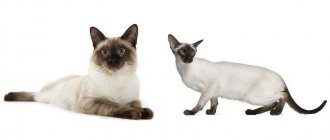Thai cats are graceful animals with an affectionate nature and expressive blue eyes. They are closely related to representatives of the Siamese breed and have many common features, which arouse genuine interest. In order not to be disappointed by such a neighborhood, before buying a pet of this breed, it is better to study in detail everything about Thai cats.
Brief history of the breed
Thailand, which in ancient times was called Siam, is considered the homeland of these cats. The first mention of similar animals was found in the manuscript “Book of Poems about Cats,” which dates back to the 14th-15th centuries. and is kept in the National Library of Bangkok. In those days, they lived exclusively at Buddhist temples and royal palaces. These cats not only destroyed rodents, but also allegedly protected their owners from evil spirits. Therefore, they were carefully protected.
Unusual cats came to Europe only in the second half of the 19th century. The Thai king, as a sign of his highest mercy, presented the English diplomat Owen Gould with a pair of cats of this breed as a gift. Unusual animals with interesting colors have created a real sensation in the British capital. Having learned about this, the ruler of Siam, Chulalongkorn, presented the high-ranking British with several dozen purebred individuals, with which the targeted breeding of Thais in Europe began.
By the middle of the 20th century, cats gained popularity in the United States and quickly spread throughout the world.
Unrecognized colors
In Holland and England, breeders are working hard to create the Apricot Point and Silver Point colors. These species are not yet recognized, as they appear as a result of a spontaneous, but still unclear mutation.
Experts believe that there is no point in recognizing new colors, since they are very similar to existing ones, and a layman cannot determine the line between them (and not all professionals recognize the differences).
Interesting Facts
During the existence of the breed, many interesting things have been associated with the Thai cat:
- At the first exhibitions in Moscow and Leningrad they were exhibited under the name “Old Siamese” in the “Beginners” category.
- Thai kittens are born with snow-white fur. Dark markings begin to appear towards the end of the first month of life.
- In the Middle Ages, exporting Thai cats from Siam was punishable by death.
- Representatives of the breed were used to breed Burmese and Balinese.
- The 1991 Thai Cat Standard is currently under revision. Therefore, only those individuals whose registration documents contain the signatures of two experts are allowed for breeding.
Origin
The history of this breed goes back about six centuries and is inextricably linked with Thailand, which was formerly called Siam. The first description of Thai cats appeared in historical manuscripts of the 14th century. Then these animals were constant companions only of the rich and noble families of Siam, and together with the monks they became an integral part of Buddhist temples.
European travelers brought representatives of the breed from Thailand only at the beginning of the nineteenth century. Blue-eyed cats immediately won the hearts of felinologists of the Old World. Work began on improving the breed's qualities, and as a result, a Siamese cat with a more wedge-shaped head and refined limbs appeared. Thus, the Thai cat contributed to the formation of the Siamese breed.
Standards, appearance, description of the Thai cat
Thais are compact, stocky animals, similar to plump Siamese. They have strong bones and a flexible body, covered with short hair of an unusual color.
Find out more, “How to distinguish between Thai and Siamese cats.”
Dimensions and weight
Thais are medium-sized animals with moderate sexual dimorphism. Their weight ranges from 4-8 kg. The Thai cat looks sleeker and smaller than a cat.
Anatomical characteristics
According to the generally accepted breed standard, the Thai cat must meet the following description:
- The head is rounded, with smooth contours, a clearly defined muzzle, a moderately convex forehead and a straight nose.
- The eyes are large, slightly slanted. They are shaped like almonds or lemons. The color of the Thai cat's iris varies from sky blue to deep blue.
- The ears are medium in size, set far apart, wide at the base, with rounded tips.
- The body is dense, with developed muscles, a short neck and a wide chest.
- The limbs are muscular, strong, proportional to the size of the body. The paws are small and rounded.
- The tail is short, wide at the base, with a slightly pointed tip.
Color and coat type
Taika is a short-haired cat with a thin silky coat and poorly developed or absent down.
Representatives of the breed are characterized by the so-called Siamese color. The body of Thai cats is covered with light hair. And on the ears, paws, muzzle and tail of the animals there are contrasting marks. According to the standard, the color of Thai cats is:
- Blue Point. There are blue markings against the main cold background.
- Seal point. Dark brown, almost black markings are evenly distributed on the cat's body.
- Cream point. The spots are colored in a creamy shade, reminiscent of the color of baked milk.
- Red Point. In this case, the cat is white with red markings distributed throughout its body.
- Chocolate point. There are dark chocolate colored markings on a darkened background.
- Torty point. This is a rare spotted color. It combines red and black tones on a basic beige background.
- Tabby point (tabby point). A cat of this color has striped markings on its body. Depending on their shade, the color may be called differently. For example, a Thai with a cool blue coat will be designated as a blue tabby point.
- Lilac Point. This color is a combination of a milky background and light blue-gray markings.
- Fawn point. Light pink markings are distributed throughout the Thai's magnolia coat.
- Caramel point. A combination of light red spots with a white background.
On a note. With any color, the color of the nose and paw pads is in harmony with the tone of the coat. In individuals with red point colors they are pink. In a seal point Thai cat, these parts of the body are dark brown.
Possible breed defects
Flaws in appearance, in the presence of which a Thai cat will not receive a high expert assessment:
- creases on the tail;
- white spots on the fur;
- strabismus;
- round or excessively slanted eyes.
Cream point
Amazingly beautiful color! The fur is white, diluted with a warm creamy tint. Point markings have a darker, contrasting cream color. The points may also have marks - small stripes. Experts do not consider them a disadvantage, but it will still be better without their presence.
The paw pads and nose are pink. Another noteworthy nuance is the presence of freckles on the lips, soles and eyelids in the form of a scattering of small brown spots. Freckles are an optional but attractive part of the color.
Character and temperament
Thai cats are curious and spontaneous animals that remain playful until the end of their lives. They quickly get used to people and do not like to be left alone. Thais are born actors, capable of constantly surprising and amusing their owners. Restless and funny representatives of the breed love to be the center of attention and enjoy exploring new territories.
The peaceful nature of the Thai cat makes it a real favorite of children. The delicate animal will never let out its claws and will not bite a naughty child.
Although the Thai cat prefers to spend time in the company of people, he gets along without problems with his relatives and good-natured dogs. He does not tolerate jealousy and fighting, which means he will not conflict with other pets, conquer territory or compete for his master’s attention.
How to choose the right kitten
The Thai breed is not rare or exotic. Therefore, problems with finding a kitten usually do not arise. In order not to become a victim of deception and not to buy a mixed breed, it is advisable to purchase an animal from a certified nursery or from a trusted breeder. At the time of the transaction, the Thai kitten must have a veterinary passport with vaccination marks and a document confirming its breed.
It is also important to pay attention to the behavior and living conditions of the animals. Thai kittens should be active, cheerful and neat. They should not have squints, kinks on the tail, white spots on the points, scratches on the skin and bald spots on the coat. The health of little Thais can be judged by the absence of bad breath, dirt under the tail, bloating, and purulent discharge from the eyes and ears.
Kitten care
Responsible breeders donate Thai kittens to new homes no earlier than they are 12 weeks old. By this age, babies are already accustomed to the tray, know how to use a scratching post and eat many foods with appetite. Therefore, new owners just have to wait until the furry pet gets used to the changed conditions and show him where his bowls, bed and toilet are located.
To prevent the little researcher from becoming a victim of an accident, household chemicals, small objects, indoor plants and wires are removed from him. Also, for safety reasons, the Thai kitten is denied free access to open ovens, washing machines and windows.
Possible problems
There are no serious problems with this breed, but when buying such a pet you should consider a number of points:
- Cats are very attached to their owner, and at first they will follow on his heels.
- Since childhood, kittens are very talkative, and this does not go away with age.
- Since the breed was bred in Thailand, the pets do not tolerate cold climates well.
- Animals are very curious, so it is better to close doors and windows tightly, as cats are able to escape.
Care and maintenance
Thai cats have an acromelanic coloration that darkens in the cold. Therefore, their content has some features. In the room where Thai cats live, it is necessary to maintain the air temperature at 23-25 °C. Otherwise, caring for representatives of the breed comes down to basic hygiene and proper feeding.
Hygiene procedures
In order for Thai cats to look neat, they are provided with appropriate care:
- Animals' eyes and ears are regularly checked for unusual discharge and gently wiped with a moistened cotton swab.
- As the cat's claws grow, they are trimmed as carefully as possible with a nail clipper so as not to injure living tissues and cause pain to the Thai.
- Animals' teeth are cleaned 2-3 times a month with a non-foaming paste and a silicone brush or a special attachment.
Grooming
A Thai cat does not require as much care as a long-haired cat. To make the fur of a representative of the breed look neat, it is combed 2-3 times a week with a brush with natural soft bristles or a special glove. During the molting period, the procedure is carried out more often to speed up the process of coat change.
The Thai cat is bathed 3-4 times a year using special shampoos. During bathing procedures, it is important to ensure that water does not get into the animal’s ears. And after washing the Thai, they wipe it dry with a terry towel.
Tray
The Thai cat is characterized by increased cleanliness. To make it convenient for her to relieve herself, they buy a spacious and deep tray. There are no special requirements for the filler. The main thing is that it fulfills its functions and the cat likes it.
Feeding the cat
In order for a Thai cat to develop properly and stay healthy longer, she needs a balanced diet.
Complete diet
When feeding dry food, a Thai cat is given premium or super premium class products - it contains all the necessary substances. It is important that its composition does not contain soy, dyes, preservatives and other dubious components. Thai cats eat well the following brands of food:
- Hills;
- Farmina;
- Pronature;
- Brit Care.
With a natural type of nutrition, representatives of the breed are selected a diet that contains 70-80% meat. Thai cats are also given:
- porridge with water;
- offal;
- boiled eggs;
- vegetables;
- sour milk;
- sea fish.
Pork, potatoes, beans, sweets, baked goods and sausages are permanently excluded from the menu of Thai cats. Also, the animal is not given river fish, bones, fresh milk, exotic fruits or any food from the owner’s table.
Feeding frequency
Thai kittens eat less, but more often than adult representatives of the breed. Therefore, when drawing up a feeding schedule, be sure to take into account the age of the pet:
- up to 12 weeks – 5-6 times a day;
- 3-6 months – 4 times a day;
- 6-12 months – 3 times a day.
One-year-old cats of the Thai breed are transferred to double feeding.
Vitamins and minerals
In the body of a Thai cat that eats natural food, a lack of microelements may occur. To make up for this deficiency, a representative of the breed is given special feeding courses twice a year. When choosing a supplement, they are guided by the advice of a veterinarian and the characteristics of a particular Thai.
Important. Thai cats that eat high-quality dry food do not need vitamin-mineral supplements.
Education and physical activity
Thai cats are endowed with extraordinary intelligence. Highly intelligent animals perfectly understand human speech and quickly understand what is required of them. Thais are easy to train and are able to follow simple commands.
On a note. An important characteristic of Thais is their innate stubbornness. They try by any means to achieve what they want. What will help you cope with this character trait of a Thai cat is not physical strength, but limitless patience.
Thais are energetic animals, unable to sit still for long. So that they don’t get bored, they get several toys and set up a special corner with different ladders and multi-level platforms.
Red point
One of the most interesting animal color options. The cat's coat is white, but a slight tint of apricot gives it a warm tint. The points are not even red, but red and gold in color, which stand out with bright spots. It is possible, but not desirable, to have small stripes on the marks.
The pads and nose are soft and pink. On them, as on the eyelids and lips, the presence of small freckles is welcome.
Blue eyes look especially bright against the background of this color! An incredibly beautiful combination, for which many people choose such cats (despite the fact that they are not the rarest).
Vaccinations and antiparasitic treatment
To prevent a Thai cat from contracting viral or infectious diseases, it is regularly vaccinated. The complex drug activates the development of stable immunity to calcivirosis, panleukopenia and rhinotracheitis. The first vaccination is given to the animal at the age of 7-8 weeks. After 21-28 days, the Thai is vaccinated against the same diseases and against rabies. In the future, a cat of this breed is vaccinated once a year.
To prevent diseases transmitted by worms and fleas, the Thai is periodically subjected to antiparasitic treatment. Anthelmintic drugs are given to a cat of this breed twice a year with mandatory repetition after 10-14 days. Thais are protected from fleas with drops, shampoos and collars.
Torty point
Only representatives of the female half of the Thai breed can boast of such a beautiful variegated coat color. For many people, this coloring came as a surprise, since it is almost impossible to recognize on kittens. From a white lump, as it grows up, a beautiful white cat grows with soft peach markings, on which there are speckles interspersed in all shades of black and red. In kittens, these inclusions are small or absent altogether, but appear later.
If you want a unique animal, then take a closer look at the torty point, because it is simply unrealistic to meet a twin by color. Each cat has a unique pattern on its points; it can even change as the animal grows older.











